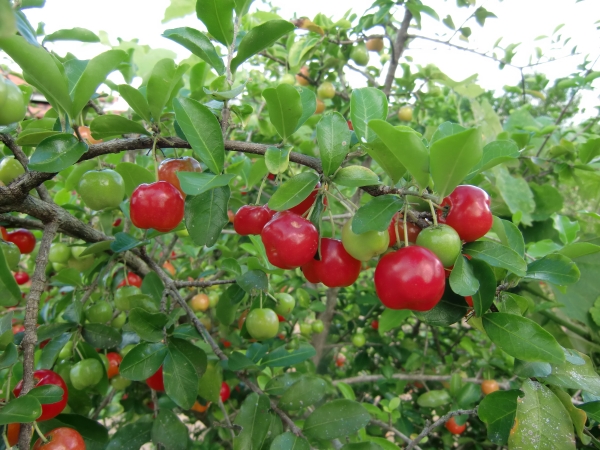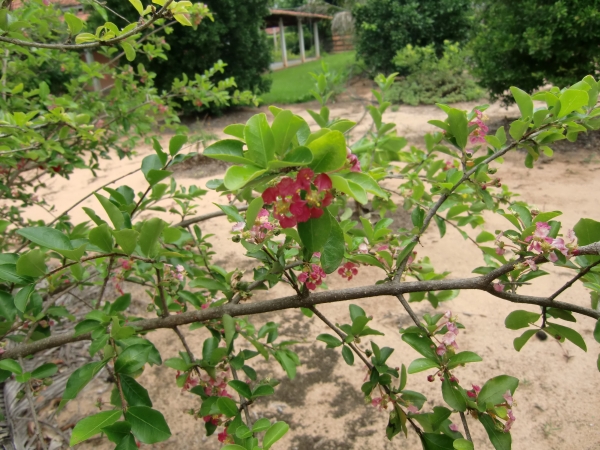

Malpighia glabra (Acerola Berry, Acerola)
Acerolas are evergreen, procumbent shrubs or small trees from the family Malpighiaceae with growth heights of mostly 3 to 10 feet, rarely also to 33 feet. The bark of young branches is green and sparsely covered with hairy trichomes which drop in old age. The bark is smooth or with conspicuous cork pores.
The opposite leaves are frequently to almost leathery. the shape of the leaf blade ranges frrom about elliptical to ovate-lanceolate. the leaves are usually 1.2 to 3 (rarely 0.8 to 4.4) inches long and 0.6 to 1.6 (rarely 0.8 to 1.2) inches wide. Forward towards the leaves are tapered or rarely acuminate, the base is tapered to a wedge or rarely rounded. The petioles have a length of 1.5 to 2 (rarely 1 to 3) mm, they are usually only rarely sparsely hairy, but it looses in the age. They are subulate and 0.5 to 1 mm long.
The umbellate or rarely bunchy inflorescences usually consist of four to six, rarely two to eight blossoms. The slender, green to reddish colored inflorescence stem is hairy or rarely glabrous, its length is 5 to 12 , rarely also 2 to 25 mm. The inflorescence axis is usually glabrous , rarely hairy and 3 to 5 (rarely 2 to 7) mm long. The bracts are 1 to 1.5 (rarely to 2 mm long), the outside bracts are 0.5 to 1 mm long. The green, hairless or nearly hairless blossom stems have a length of usually 7 to 11 (rarely 5 to 15) mm. Among the sepals sometimes there is a ring of bristles.
The buds have a diameter of usually 4 to 5, rarely 3 to 6 mm. The flower diameter usually is 1.3 to 1.8 (rarely 1 to 2) cm. In the bud the sepals are hairy, but they are balding soon. Between sepals and petals are six mostly oil glands, sometimes there are seven to ten, then the extra oil glands are very small. The posterior petals are 6.5 to 9.5 (rarely 6 to 11) mm long, the hem is sometimes strongly reflexed. The petals are medium with 5.5 to 7 (rarely 5 to 8.5 mm) slightly shorter, the anterior petals are the shortest in length from 5.5 to 6.5 (rarely 4 to 8) mm.
The androecium is radially symmetric impedance, but filaments are thread-like, similar in thickness, or are only slightly different thick. They are straight, 2.5 to 3 (rarely 2 to 3.5) mm long. The anthers are usually of equal length, only occasionally are lying at the side of anthers somewhat larger. Its length is between 0.8 and 1.2 mm. Even the gynoecium is radially symm etric structured. The styles are 2 to 2.5 (rarely 1 to 3) mm long, the top is blunted or truncated, the long ovary is not parted.
The nerly spherical stone fruits have a diameter of 1 to 1.5 cm, are usually smooth and unlobed. The ovoid seeds are 7 to 10 mm long and 5 to 7 mm wide. they are winged with a 1 mm wide entire margin wings at the back, side wings are not forming.
Acerola is common in an area that includes Texas, Mexico, Panama and Guatemala, also in Jamaica, there are reserves. Within their range there are huge variations in growth habit, it is found in northern Mexico and Texas, often cllimbing shrubs throughout Mexico, Texas and Jamaica, and small shrubs, while prevalent throughout the range mostly large shrubs and small trees. Outside the natural range of the species is rarely cultivated.
This specis grows in a variety of sites, from moist ravines and river banks on roadsides and moist lowland forests to sites on dry rocky limestone slopes. The sites are situated at altitudes between sea level and 5333 feet.
The fruits of the acerola cherry are used as fruit. They belong to the fruits which are most rich with vitamin C.

Acerola in our garden in December 2009.

Acerola flower in December 2009.
Back to the Agricultural Plant List
Updated by Joachim Jaeck on March 10th, 2010